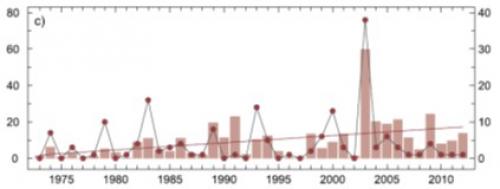Julien Ruffault (OT-Med post-doc)
Thomas Curt (RECOVER, now INRAE)
Vincent Moron (CEREGE)
Ricardo Trigo (Lisbon University)
PYROMED
Wildfires are a main threat to humans and ecosystems in the Mediterranean area and global changes are predicted to alter fire regimes during the next decades. In this context, the assessment of the main drivers of fire activity in the Mediterranean area is of particular importance for policy-makers and land managers in order to mitigate its impact on ecosystems, human lives and facilities
Among the biophysical and human drivers of fire activity, the variations in climatic/weather conditions are one of the main drivers of fire activity. Yet, in Southern France, this climate/weather fire relationship remains partly unknown. We aim to address the following issues: (i) Assessing the local meteorological and synoptic conditions that drive fire activity, with special focus on atmospheric conditions associated with largest fires (as those during the summer of 2003); (ii) Estimating the future of fire-related climatic conditions (as frequency of the weather types related to large fires) till 2100 using CMIP5 runs.
PYROMED 2
Unravelling the wildfire-climate relationships over the Mediterranean
While the frequency of extreme, disastrous wildfire seasons is expected to increase in the Mediterranean region because of global changes, Pan-Mediterranean risk mitigation strategies are still hampered by a lack of understanding of the physical and climatic factors that drives fire activity at the continental level. Building on the results achieved over Southern France during the Pyromed project funded by OT-Med, Pyromed2 aims at unraveling some fundamental aspects of the fire-climate relationships to improve our understanding and predictions of where and when wildfire occur over the Mediterranean
This project has identified multiple fire climatologies that promote large (> 120 ha) wildfires in France, based on their climatic and meteorological drivers from 1973 to 2012. It has demonstrated that three types of synoptic conditions promote large fires: near-normal conditions, wind-driven conditions, and heat-driven conditions. Heat-driven conditions increased along time due to the ongoing climate changes (see Figure), thus promoting dangerous fires with high energy. They correspond to heatwaves, very low values of air humidity, and very high values of fire dangers indices. As these synoptic conditions establish for several days or weeks, this allows predicting the occurrence of large fires.
Historical reconstruction of the yearly number of summer large fires (LFs,>120 ha; right y-axis) and of the yearly percentage of summer voxels suitable for burning (left y-axis) for the heat-driven type



